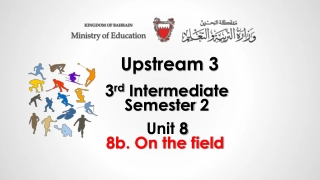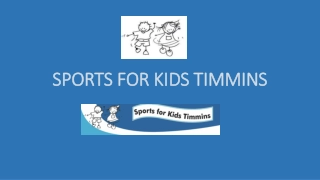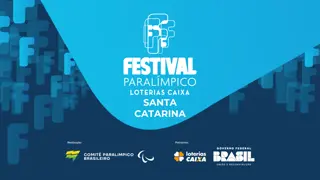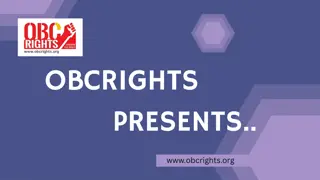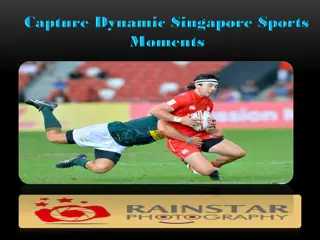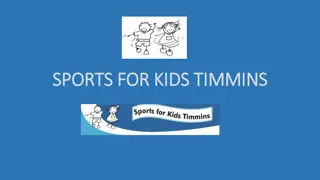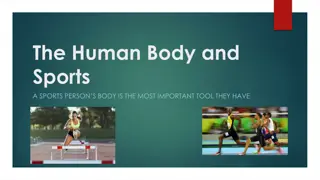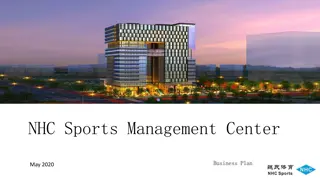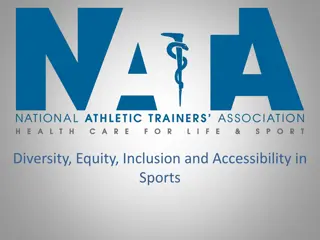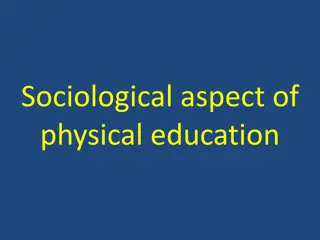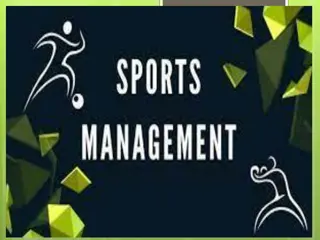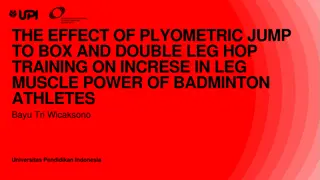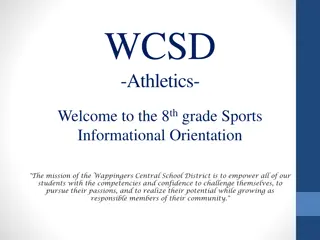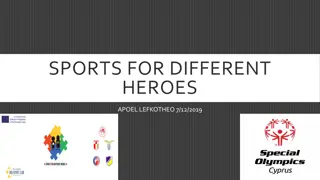Empowering Child Athletes: Enhancing Participation in Sports
Empower child athletes by actively involving them in decision-making processes within sports, transitioning from mere lip service to meaningful engagement. Dr. Mel Lang leads a webinar discussing the importance of youth participation, benefits, challenges, and initiatives for building a culture that values their insights and opinions. Learn how children's participation is a fundamental right that fosters agency, autonomy, social skills, and self-esteem, shaping confident and socially adept individuals.
Download Presentation

Please find below an Image/Link to download the presentation.
The content on the website is provided AS IS for your information and personal use only. It may not be sold, licensed, or shared on other websites without obtaining consent from the author. Download presentation by click this link. If you encounter any issues during the download, it is possible that the publisher has removed the file from their server.
E N D
Presentation Transcript
Including Child Athletes in Decision-Making in Sport: Moving from Lip Service to Active Participation Dr Mel Lang SIMS webinar, 12thOctober 2022 ehu.ac.uk
Introduction Reader (Associate Professor) in Child Protection & Safeguarding in Sport Co-founder and Director of the Centre for Child Protection and Safeguarding in Sport (CPSS) Member of the Council of Europe s Pool of European Experts on Safe Sport Member of SIMs Former elite (youth) athlete & lived experienced of abuse ehu.ac.uk
Overview Defining participation Benefits of youth participation and the challenges Surveying the (sports) field Where is sport at? Example initiatives (and a BIG caveat) Building a culture of participation Conclusion and Q&A ehu.ac.uk
Defining participation State parties shall assure to the child who is capable of forming his or her own views, the right to express those views freely in all matters affecting the child, the views of the child being given due weight in accordance with the age and maturity of the child. (UN General Assembly, 1989, Article 12(1)) = a shift from a welfare-based approach to children to a rights-based approach Participation = a process where children are enabled to give their opinions, are listened to, and influence decisions about their lives to bring about change ehu.ac.uk
Childrens participation: 2 key points The participation of children and young people plays a fundamental role in realising all the rights in the Convention for all children (UNICEF, no date) Other rights cannot be realised without the actualisation of children s participation rights Gathering children s views is not analogous with participation We must hear and act uponchildren s opinions, not just listen to them ehu.ac.uk
The benefits of participation Develops understanding of agency and autonomy, social skills, group and interpersonal skills Enhances self-esteem and confidence, promotes pro-social behaviour Increases political understanding, social inclusion and awareness of rights Breaks down power imbalances between adults-children in sport = empowers children Creates innovative and more athlete-centred sporting spaces Shows the value that an organisation places on children and on supporting them Supports the identification of potential concerns (including safeguarding concerns) Encourages trust vital for disclosures (Hart, 1992; Harris & Manatakius, 2013; Kitzinger, 1997; Lang, 2022; Smith, 2012; Whitty et al., 2007) ehu.ac.uk
Challenges to participation Incorporating children s views can be challenging! Practical/ material challenges: funding, resources, staffing, facilities Structural/ socio-cultural challenges: hierarchical power dynamics, traditional understandings of children as seen but not heard , resistance from staff, fear, lack of expertise/ confidence (James & Prout, 1997; Everley, 2021; Lang, 2022 Tucker, 2011) ehu.ac.uk
Where is sport at? Most policy, practice & research developments to date have focused on children s protection rights in sport far less attention paid to children s participation rights (Lang, 2022) Children are rarely involved in decision-making in sport: Policy/ strategy developments Recruitment decisions Induction programmes Education and training Training plans Team selection Research (Everley, 2021; Lang, 2022; Lang & Purdy, 2023) ehu.ac.uk
Where is sport at? Everley (2021) found most UK clubs said they valued the inclusion of children s voices but 68% did not think they were expected to include children in decision-making Some adult resistance to listening to children s voices a legacy of welfare-based approach Most clubs that did try to engage with children did not do so directly used an intermediary (parent, coach, welfare officer etc.) = mediation not active representation ehu.ac.uk
Where is sport at? 40% of adult welfare officers thought that children couldn t effectively participate because either they couldn t understand what was going on or they couldn t express themselves 29% felt children couldn t understand the paperwork used in meetings 24% said children wouldn t be able to understand the consequences of decisions made that they are contributing to (Everley, 2021) ehu.ac.uk
Example initiatives and a caveat The following may ormay not contribute to children s active participation in sport. Participation should not be seen as a one-off event or initiative approached as a tick-box exercise Ask children to join existing committees and to lead/ chair them Allow children to choose their own goals or priorities Involve children in policy development/review Involve children in staff training/workshops and offer training tailored to children Involve children in coach/staff recruitment and annual performance reviews Involve children in research as participants but also as researchers ehu.ac.uk
Example initiatives Use a range of approaches to engage with children regularly (questionnaires, surveys, focus groups, communication book ) Have champions of children s participation/ children s advocates and child leaders/ambassadors Require a commitment to children and young people s participation in all job descriptions Hold staff workshops to discuss or generate ideas for including children in your organisation and child-only/led agenda days for children Evaluate initiatives and share best practice Respect children s views if they DON T wish to get involved ehu.ac.uk
Building a culture of participation A trio of teenage girls were grouped together talking in the leisure centre foyer after training. One girl mentioned she didn t enjoy the session as much as usual. A second girl commented on the coach s coaching style. The third added she d enjoyed the session but wished they d had a longer cool down as she was sore. A club official nearby, who was eavesdropping on the conversation, popped their head into the group and, with a smile and a roll of their eyes, jokingly said, you re a right bunch of old moaners, you lot! ehu.ac.uk
The Lundy model (Lundy, 2007) 1. Children must be given the opportunity & the space to express their views 2. Children must be facilitated to express their views 3. Children s views must be listened to 4. Children s views must be acted upon (as appropriate) ehu.ac.uk
Building a culture of participation SPACE 1. Have children s views been actively sought? 2. Is there a safe space in which children can express themselves? 3. Have steps been taken to ensure that all children can take part? ehu.ac.uk
Building a culture of participation VOICE 1. Have children been given the information they need to form a view? 2. Do children know that they do not have to take part? 3. Have children been given a range of options as to how they might choose to express themselves? ehu.ac.uk
Building a culture of participation AUDIENCE 1. Is there a process for communicating children s views? 2. Do children know who their views are being communicated to? 3. Does that person/body have the power to make decisions? ehu.ac.uk
Building a culture of participation INFLUENCE 1. Were the children s views considered by those with the power to effect change? 2. Are there procedures in place that ensure that the children s views have been taken seriously? 3. Have the children been provided with feedback explaining the reasons for decisions made? ehu.ac.uk
Conclusion Meaningful participation is a long-term systematic process, not simply the application of isolated participation activities or events It requires: Transforming traditional paternalistic attitudes to children and forging new child- adult relationships rooted in mutual respect Rethinking traditional patterns of behaviour, processes, practices and systems in sport that may be inconsistent with the notion of children s participation rights Adults to embrace change and see children s participation as a positive development, one that will enhance our sports communities and practice (James & Prout, 1997; Lang, 2022; Lansdown, 2001; Lundy, 2007) ehu.ac.uk
Questions? Melanie.Lang@edgehill.ac.uk @DrMelLang
Work Cited Everley, S., 2021. The Child Protection in Sport Unit: Supporting national governing bodies in hearing the voices of children An evaluation of current practice. Child Abuse Review,29 (2), pp. 114-129. Harris, P. & Manatakius, H., 2013. Children as citizens: Engaging with the child s voice in educational settings. New York: Routledge. James, A. & Prout, A. 1997. Constructing and reconstructing childhood: Contemporary issues in the sociological study of childhood. London: Taylor & Francis. Kitzinger, J., 1997. Who are you kidding? Children, power and the struggle against sexual abuse. In A. James, C. Jenks & A. Prout (Eds.) Constructing and reconstructing childhood: Contemporary issues in the sociological study of childhood. London: Taylor & Francis. Lang, M., 2022. Advancing children s rights in sport: Coaching, childhood agency and the participatory agenda. Sports Coaching Review, 11 (1), pp. 41-63. Lang, M., & Hartill, M., 2015. Safeguarding, child protection and abuse in sport: International perspectives in research, policy and practice. London: Routledge. Lang, M. & Purdy, L., 2023. Child's play? Safeguarding and protecting children in sport.In M.Toms & R. Jeanes (Eds.) The Routledge Handbook of Coaching Children. London: Routledge. Lansdown, G., 2001. Promoting children s participation in democratic decision-making. Geneva: UNICEF. Lundy, L. 2007., Voice is not enough: Conceptualising Article 12 of the United Nations Convention on the Rights of the Child. British Educational Research Journal, 33 (6), pp. 927-942. Smith, A.-M., 2012. Paving the way for pupil voice? School council s campaign for fairtrade in Liverpool. In S. Cox et al. (Eds.) Children as decision makers in education: Sharing experiences across cultures. London: Bloomsbury. ehu.ac.uk
Work Cited Tucker, S., 2011. Listening and believing: An examination of young people s perceptions of why they are not believed by professionals when they report abuse and neglect. Children and Society, 25, pp. 458-469. UNICEF, n.d. The Right to Participate. https://www.unicef.org.uk/rights-respecting-schools/the-right-to- participation/#:~:text=The%20Right%20to%20Participation%20is%20one%20of%20the,the%20rights%20in%20the%20Convention%20for%20all%20children League of Nations, 1924. Geneva declaration of the rights of the child. http://www.un-documents.net/gdrc1924.htm UNICEF, 2005a. Survival and development rights. http://www.unicef.org/crc/files/Survival_Development.pdf UNICEF, 2005b. Protection rights. http://www.unicef.org/crc/files/Protection_list.pdf UNICEF, 2005c. Participation rights. http://www.unicef.org/crc/files/Participation.pdf UN General Assembly, 1948. Universal declaration of human rights. https://www.un.org/sites/un2.un.org/files/udhr.pdf UN General Assembly, 1959. Declaration of the rights of the child https://www.ohchr.org/EN/Issues/Education/Training/Compilation/Pages/1DeclarationoftheRightsoftheChild(1959).aspx UN General Assembly, 1989. Convention on the rights of the child. www.unhcr.org/refworld/docid/3ae6b38f0.html Whitty, G. et al., 2007. Real decision-making? School councils in action. London: HMRS. ehu.ac.uk


